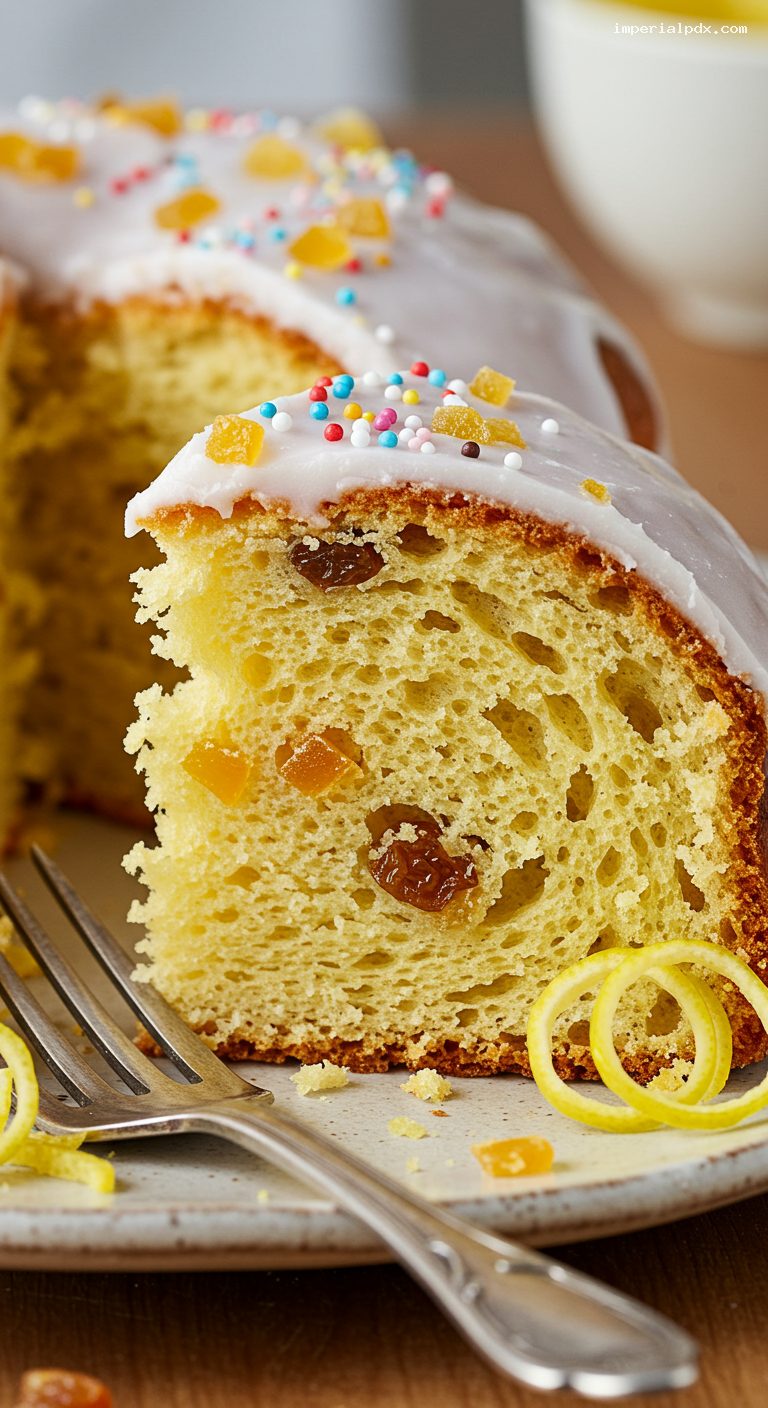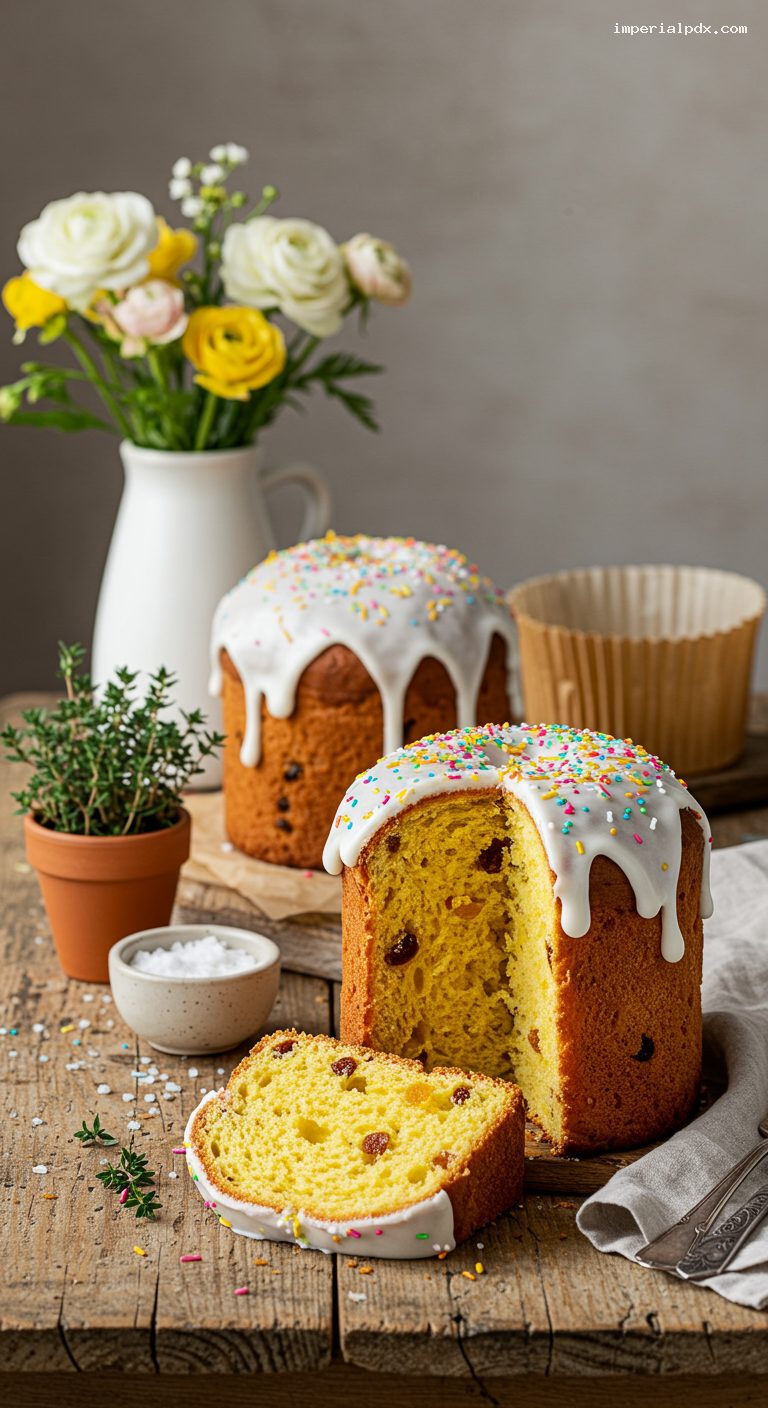Quick Recipe Version (TL;DR)
Quick Ingredients
- 240 ml warm whole milk (105–110°F)
- 9 g active dry yeast (1 packet)
- 150 g granulated sugar
- 540 g bread flour
- 7 large egg yolks + 1 large egg
- 120 g unsalted butter, very soft
- 1.5 tsp fine salt
- 2 tsp vanilla extract; zest of 1 lemon and 1 orange
- 200 g mixed candied citrus peel and golden raisins, soaked in 2 tbsp rum or hot water
- Icing: 240 g powdered sugar, 2–3 tbsp lemon juice, 1–2 tbsp warm milk/water
- Colorful sprinkles to finish
Do This
- 1) Soak fruit in rum (or hot water) 20 minutes; drain and pat dry. Bloom yeast in warm milk with a pinch of sugar, 5–10 minutes.
- 2) Mix flour, sugar, salt, zest. Add bloomed yeast mixture, eggs/yolks, vanilla; mix to shaggy dough.
- 3) Knead 8–10 minutes (stand mixer) until elastic; add soft butter in pieces; knead 6–8 minutes more until smooth and slightly tacky. Fold in fruit.
- 4) First rise: cover and let double, 1½–2 hours at warm room temp (75–80°F).
- 5) Prepare two tall cylindrical tins or paper molds; line if needed. Divide dough, shape into tight balls, place in molds. Second rise until ¾ up the sides, 45–75 minutes. Preheat oven to 350°F (175°C).
- 6) Bake 35–45 minutes until deep golden and 190–195°F inside. Cool 45–60 minutes, then spoon on thick lemon glaze and add sprinkles.
Why You’ll Love This Recipe
- Classic Eastern European celebration bread with a soft, feathery crumb and buttery richness.
- A tall, festive shape baked in cylindrical tins that looks stunning on the table.
- Bright vanilla-citrus flavor and jeweled candied fruit in every slice.
- Glossy lemon icing with cheerful sprinkles for a joyful finish.
Grocery List
- Produce: 1 lemon, 1 orange
- Dairy: Whole milk, unsalted butter, large eggs
- Pantry: Bread flour, granulated sugar, powdered sugar, active dry yeast, fine salt, vanilla extract, candied citrus peel, golden raisins, rum (or use hot water), sprinkles
Full Ingredients
For the Fruit Mix
- 200 g mixed candied citrus peel and golden raisins (about 1⅓ cups total)
- 2 tbsp dark rum (or hot water or orange juice)
For the Dough
- 240 ml whole milk, warmed to 105–110°F (1 cup)
- 9 g active dry yeast (2¼ tsp; 1 packet)
- 150 g granulated sugar (¾ cup)
- 540 g bread flour (4¼ cups), plus extra for dusting
- 7 large egg yolks (about 125–130 g)
- 1 large egg
- 120 g unsalted butter, very soft but not melted (8 tbsp)
- 1½ tsp fine sea salt
- 2 tsp pure vanilla extract
- Finely grated zest of 1 lemon and 1 orange
- Optional: ¼ tsp ground cardamom or a pinch of saffron soaked in 1 tbsp hot milk for color
For the Icing & Topping
- 240 g powdered sugar (2 cups)
- 2–3 tbsp fresh lemon juice
- 1–2 tbsp warm milk or water, as needed for consistency
- Pinch of fine salt (balances sweetness)
- 2–3 tbsp colorful sprinkles
For the Molds
- Two tall paper panettone molds (about 4¼–4¾ inches diameter, 4–6 inches tall) or two clean 1-qt metal cans lined with parchment (with a 2-inch collar above the rim)
- Neutral oil or butter for greasing if using metal tins

Step-by-Step Instructions
Step 1: Soak the fruit and proof the yeast
Combine the candied peel and raisins with the rum (or hot water/orange juice). Let soak for 20–30 minutes, then drain and pat very dry with paper towels (excess moisture can make the dough heavy).
In a measuring cup, whisk the warm milk with the yeast and a pinch of the sugar. Let stand 5–10 minutes until foamy.
Step 2: Make the enriched dough base
In the bowl of a stand mixer, whisk together the flour, remaining sugar, and salt. Add the bloomed yeast mixture, egg yolks, whole egg, vanilla, and citrus zests (plus cardamom or saffron-milk if using). Mix with the dough hook on low until a shaggy dough forms, 2–3 minutes. If mixing by hand, stir with a sturdy spoon until combined.
Step 3: Knead and add butter
Increase mixer speed to medium and knead until the dough becomes elastic and begins to clear the sides, 6–8 minutes. With the mixer running, add the softened butter a tablespoon at a time, letting each piece fully incorporate before adding the next. Continue kneading 6–8 minutes more. The dough should be smooth, slightly tacky, and very supple. It will pass a windowpane test. Knead in the well-dried fruit just until evenly distributed.
Step 4: First rise
Form the dough into a ball and place in a lightly greased bowl. Cover and let rise in a warm, draft-free spot (75–80°F) until doubled in volume, 1½–2 hours. If your kitchen is cool, this may take up to 2½ hours.
Step 5: Prepare molds and shape
Grease your cylindrical tins if using metal, and line the bases and sides with parchment, adding a 2-inch collar above the rim. Paper panettone molds need no greasing.
Turn the dough out, gently deflate, and divide into two equal portions (about 700–730 g each). Shape each into a tight ball by tucking edges under to create surface tension. Place seam side down into the prepared molds; the dough should fill each mold about halfway.
Step 6: Second rise and bake
Cover loosely and let rise until the dough reaches about ¾ of the mold height or is slightly domed over the rim, 45–75 minutes depending on room temperature. Meanwhile, preheat the oven to 350°F (175°C) with a rack in the lower-middle position.
Bake 35–45 minutes, rotating once halfway. If the tops brown too quickly, tent with foil after 20 minutes. The loaves are done when deeply golden and an instant-read thermometer in the center reads 190–195°F (88–91°C). For very tall molds, baking may take up to 50 minutes.
Step 7: Cool, glaze, and decorate
Cool in the molds on a rack for 15 minutes, then carefully remove and cool until just barely warm, 45–60 minutes more. Whisk the powdered sugar, lemon juice, and enough warm milk/water to make a thick, spoonable glaze that ribbons slowly off the spoon. Stir in a pinch of salt. Spoon over the tops, letting drips cascade down the sides. Immediately add sprinkles. Let the glaze set 20–30 minutes before slicing.
Pro Tips
- Butter temperature matters: very soft (around 68–72°F), not melted, so it emulsifies into the dough for a fine, even crumb.
- Dry your soaked fruit thoroughly; excess liquid can tear the gluten and make tunnels around fruit pockets.
- For height and support, use tall paper molds or parchment collars so the dough can climb as it bakes.
- Check doneness by temperature (190–195°F) rather than color alone; rich dough browns quickly.
- For the yellow hue, a tiny pinch of saffron steeped in hot milk adds color and floral notes without food coloring.
Variations
- Saffron-Almond Kulich: Add saffron to the dough and top the glaze with toasted sliced almonds.
- Chocolate-Apricot: Swap raisins for chopped dried apricots and fold in 60 g mini dark chocolate chips.
- Cranberry-Citrus: Use dried cranberries and extra orange zest; finish with candied orange strips on the glaze.
Storage & Make-Ahead
Store cooled kulich airtight at room temperature for 3–4 days. To freeze, wrap slices or whole loaves tightly and freeze up to 2 months; thaw wrapped at room temperature. Make-ahead option: After the first rise, refrigerate the dough up to 12 hours. Bring to room temperature, shape, proof, and bake as directed. You can also proof shaped loaves in the molds in the refrigerator overnight; allow 45–90 minutes at room temperature before baking. Glaze just before serving for the glossiest finish.
Nutrition (per serving)
Approximate per slice (1/16 of recipe): 360 calories; 12 g fat; 54 g carbohydrates; 6 g protein; 1 g fiber; 26 g sugars; 220 mg sodium. Values are estimates and will vary with specific ingredients and toppings.


